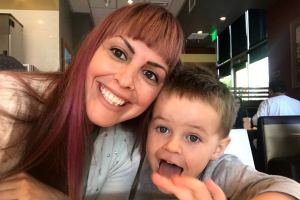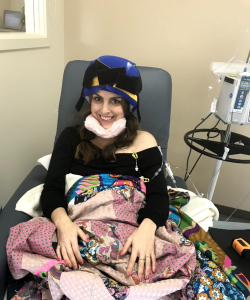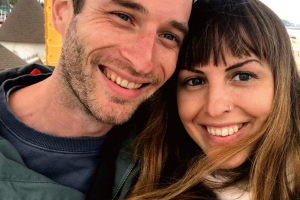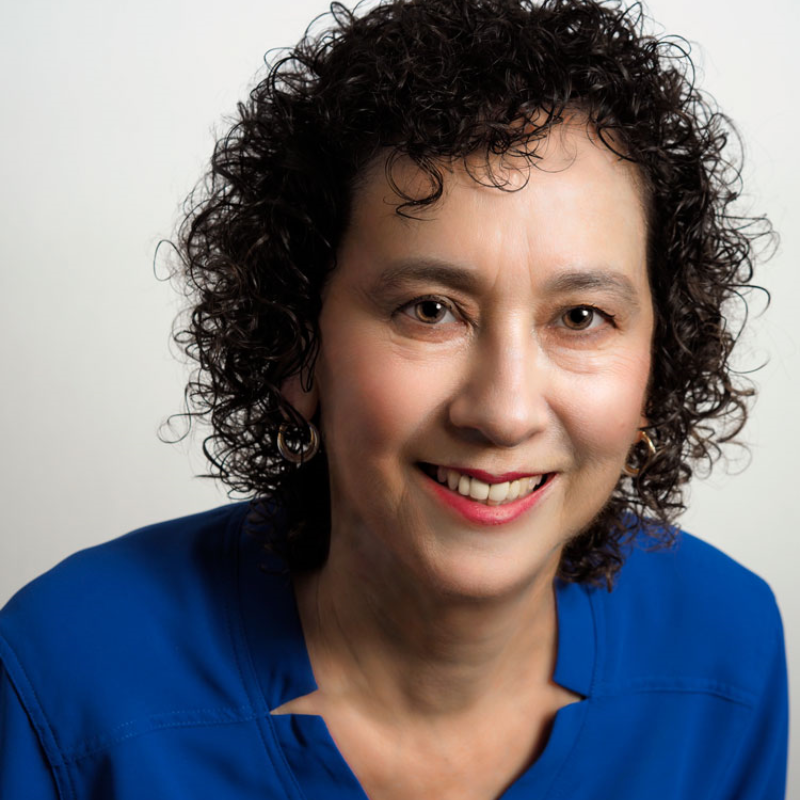Cooling the Scalp to Reduce Hair Loss: Sienna Córdoba
- 03/13/19
 Sienna Córdoba considers her hair to be “a unique part of my personality.” It’s thick and reddish-brown, like the color sienna. “I’m Colombian and German-Irish, so I have a weird mix of hair genes,” she says. “If you asked somebody what do I look like, probably they would describe my hair first.”
Sienna Córdoba considers her hair to be “a unique part of my personality.” It’s thick and reddish-brown, like the color sienna. “I’m Colombian and German-Irish, so I have a weird mix of hair genes,” she says. “If you asked somebody what do I look like, probably they would describe my hair first.”
In 2017, Sienna was 32 and living near Santa Cruz, California, teaching high school and raising a 3-year-old son, when she was diagnosed with stage II breast cancer. While reading online about treatments, she learned that making her scalp cold during chemotherapy infusions might lessen hair loss caused by chemotherapy.
Two types of scalp-cooling devices are available: manual cold caps and automated scalp cooling systems. Sienna chose cold caps. About 9 months after finishing chemotherapy and cooling, she spoke with LBBC contributing writer Robin Warshaw about her experience.
Robin: Why did you want to use cold caps?
Sienna: I saw a big psychological benefit to keeping my hair. It seemed like I had to try it at least. People have just accepted [losing all of your hair] but I’m the type of person who says, “Why are you just accepting that this has to happen?” If it doesn’t have to happen, it’s not gonna happen — for me anyway.
Also, when people find out you have cancer, they say, “Aw, you’re gonna lose your hair!” It’s like they’re looking forward to your humiliation. I don’t think it’s even conscious. I really felt I can’t let everybody get one on me. It was about control.
I got a free wig at a cancer beauty workshop. I put the wig on around my son and the first thing he did was snatch it off. He was 3. So I thought, “I’m not going to be able to wear a wig anyway because of him.”
Robin: Did your doctor talk with you about cooling your head to save your hair?
Sienna: At my first infusion center, they didn’t seem super enthusiastic about it. They didn’t even say, “We’ve seen that work,” or anything encouraging. It was completely me that brought it up.
Halfway through, I switched infusion centers but kept doing the cold caps. They had pamphlets about scalp cooling and had a lot more interest in the subject.
Robin: What was your routine on infusion days?
Sienna: My friend and I would go to Safeway and buy 50 pounds of dry ice for each session. It’s a lot of dry ice and makes quite a scene at the check-out! The cashier always would ask me what I was up to — fishing trip, art project?
We put the gel caps on dry ice in a cooler an hour before wearing. You can’t have the gel be completely solid. It has to be at a particular temperature and you don’t want to freezer burn your head.
With the system I used, you get four gel helmets that flatten out and attach on your head with Velcro straps, and a cooler. You need all your stuff to be at the exact right temperature, which you check frequently with an infrared thermometer.
My friend would wear gloves because he had to break up the gel to mold the chilled cap on my head. We switched caps every 20 minutes so they would stay at the right temperature. You take them on and off continuously. They go back into the freezer to cool down again. It’s a very old-school, intense system.
I wore the cold caps for 30 minutes before infusions, then during my infusions — which lasted 4 to 5 hours — and for 4 hours after completing the treatment.
I did TCHP [Taxotere (docetaxel), carboplatin, Herceptin (trastusumab) and Perjeta (pertuzumab)] six times over 6 months. People in the infusion center could see my hair extending out of the bottom of the cap and definitely were interested in it.
Robin: Did you feel really cold while doing it?
Sienna: Yeah. The thing is, you already know that your life sucks right now. So you’re more open to things being horrible. Your perspective changes. Having my head frozen for hours seemed doable by comparison. Other things could be way worse—like losing all of my hair.
But it is super-uncomfortable. I don’t want people to think, “Oh, this is gonna be a walk in the park.” No way. It was exhausting. By the end of each session, I would be really mad.
In terms of being cold, I would say it hurt the first minute you put on a cold cap, then it was totally fine because your head is numb. Then every time you switch it, you feel the cold again.
Robin: What were you thinking while going through all this?
Sienna: When I was feeling really sick, I looked in the mirror and I still had my hair. And I could still make myself look normal, go out anywhere and I’d just look the same as before diagnosis. That relieved me.
I knew I was doing this for my sanity. You feel like you’re doing the best you can.
Robin: Some infusion centers now have scalp-cooling systems available. Did you consider those?
Sienna: There wasn’t a cooling machine offered at my infusion center. Now some centers in the area have them and you can get your head hooked up. It’s definitely becoming more mainstream.
If I had known how much drama it would be, taking the caps on and off, I would have tried to find one of those machines and just sat hooked up. But I actually did like that my friend was with me every time. It also meant that I could leave the infusion center [after the infusion], with the crazy cold pack on my head.
Robin: Did you lose any hair despite using the caps?
Sienna: Basically, I lost the underneath part of my hair. I think that was because my hair was so thick, my scalp didn’t have a good contact with the cap.
I lost hair above my ears and around the base of my neck. It was very thin there, not noticeable to other people, but it was a significant amount.
Robin: Did your hair need special handling during those 6 months of chemo with scalp cooling?
Sienna: The cold caps manufacturer sent me a handbook that said you always want to keep your head as cool as possible. You wash your hair in cold water and can’t use any blow dryer or heat on your hair. I would just barely wash my hair with an all-natural, very gentle pine tar shampoo that I found or dry shampoo. I couldn’t brush it. You try to touch your hair as little as possible.
You’re supposed to keep that up for a month or two after treatment, but I couldn’t handle it. I needed to wash my hair and be normal.
Robin: Did health insurance pay for the cold cap process? If not, how much did it cost?
Sienna: I never figured out how to get insurance to cover it. I put it all on a credit card, which I haven’t paid off yet. I don’t know anyone who has gotten it covered, but I’ve seen it mentioned online.
It cost [me] close to $500 per infusion to rent the cold caps and get dry ice. It’s not cheap at all. So it was $3,000 to keep my hair.
I would love to advocate for insurance companies to cover it. Hair loss is a side effect of a treatment you’re getting and this is a way to manage it. Cold caps definitely helped me during treatment and the result continues to help me feel a little less traumatized.
Robin: Has your hair returned to what it was before breast cancer treatment?
 Sienna: I had my hairdresser shave it around my ears for uniform length. There was a lot of thinning around my face, so I cut bangs. My hair’s shorter than it’s been in many years, only to my shoulders.
Sienna: I had my hairdresser shave it around my ears for uniform length. There was a lot of thinning around my face, so I cut bangs. My hair’s shorter than it’s been in many years, only to my shoulders.
I think the cold caps helped the hair grow back, even though I did lose some of it. I know that 1 or 2 years from now I’ll have my normal length hair again, to the middle of my back.
Robin: How are things going for you?
Sienna: I now live in Baltimore and just finished Herceptin [trastuzumab] treatment. It comes with side effects that affect my heart, so my doctors check it regularly. I’m freelance writing and working in an after-school program where I can bring my son. It’s super-fun!
This article was supported by the Grant or Cooperative Agreement Number 1 U58 DP005403, funded by the Centers for Disease Control and Prevention. Its contents are solely the responsibility of the authors and do not necessarily represent the official views of the Centers for Disease Control and Prevention or the Department of Health and Human Services.
Stay connected
Sign up to receive emotional support, medical insight, personal stories, and more, delivered to your inbox weekly.


